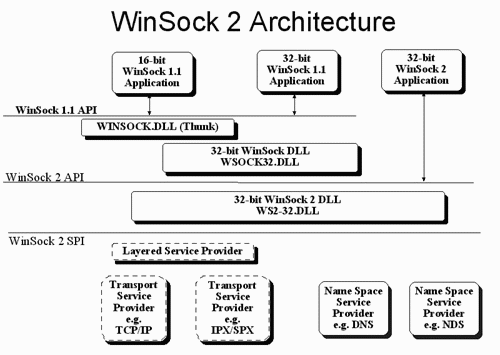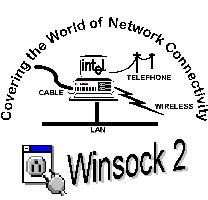What's New
What is WinSock 2?
Simply stated, Windows Sockets 2 is the API for all forms
of data communications on Microsoft's 32 bit Windows operating systems.
While preserving strict backwards compatibility, Windows Sockets 2 extends today's immensely popular WinSock v 1.1 interface
for TCP/IP networks to provide a protocol-independent
interface that is optimized to support real-time multimedia communications
and able to work across all kinds of communications infrastructures.
Windows Sockets (WinSock) is the API specification that has enabled
TCP/IP data communications on the Windows platform. Developed by
an industry-wide coalition of companies known as the WinSock Group,
the wholesale acceptance of Windows Sockets has been a key enabler of the Internet's explosive growth and is currently included in all versions of the
Windows operating systems.
Windows Sockets version 2 takes the original standard, and expands its
scope, both in depth and breadth. Windows Sockets 2 provides
multiprotocol support, quality of service, a layered provider architecture, and numerous
performance enhancements over Windows Sockets version 1.1.
Windows Sockets 2 is a network programming interface at the transport
level in the OSI reference model. Designed to the WOSA (Windows Open
Services Architecture) format it provides both an Application Programmer
Interface (API) for applications developers and a Service Provider Interface
(SPI) for transport stack vendors.
Features and Benefits
Windows Sockets 2 provides numerous enhancements to the original
specification.
Multiprotocol Support
Windows Sockets 2 significantly extends the interface by providing
applications with transport independence across a wide range of networks
and communications media types such as TCP/IP, OSI or IPX/SPX, analog
and digital telephone networks, wireless networks such as cellular and
CDPD, and emerging networks such as ATM and cable.

Applications can now be developed for portability across a variety of
transports with a common interface for all types of network stacks and
communication media.
For protocol stack vendors there is the equivalent benefit of instantly
enabling the wealth of communicating applications that will rely on
Windows Sockets 2 simply by making their transport protocols accessible
via the Windows Sockets 2 SPI.
Quality of Service
Windows Sockets 2 includes mechanisms for applications to negotiate
quality of service with a network, thus facilitating its use for multimedia
applications. Applications can discover and utilize the quality of service
(bandwidth, latency, etc.) offered by underlying networks such as ATM,
ISDN, RSVP, and Cable. Virtually all of the major ATM vendors have announced
plans for their desktop and server products to leverage WinSock 2.
Multipoint / Multicast
Windows Sockets 2 also provides generic support for both multipoint and multicast
which allows applications to discover and utilize capabilities
such as IP multicast and ATM point-to-multipoint in a protocol independent
manner. Multipoint and multicast enables end user capabilities such as
multiplayer games, conferencing, and distance learning.
Real-Time Multimedia Communications
Windows Sockets 2 was specifically engineered to enable a new breed of
applications that employ Real-time Multimedia Communications such
as video conferencing. Besides Quality of Service, there are several
other features in WinSock 2 that assist multimedia applications such as
overlapped I/O, circular queues and buffer flushing.
Layered Provider Architecture
Windows Sockets 2 includes provisions for inserting layers between the WinSock 2 DLL and the underlying protocol stack that communicates over the wire.
A layered protocol could be used to monitor and interdict URL's being accessed, implement secure authentication and encryption, or
extend the capabilities of an underlying base protocol.
Event Object Based Notification
In addition to the window message based asynchronous notification of
network events in version 1.1, Windows Sockets 2 offers event object
based notification in order to facilitate development of application servers
and deamons which require no Windows GUI components.
![]()


